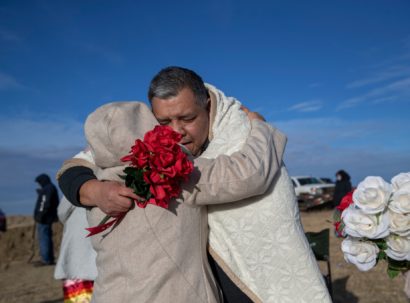Standing Rock Monument
THE STANDING ROCK SIOUX RESERVATION covers more than two million acres of grass plains, rolling hills, and buttes running alongside the Missouri River. The reservation takes its name from a sacred rock formation that resembles a woman with a child on her back. This sacred stone stands outside the Standing Rock Agency office in Fort Yates, North Dakota.
The Standing Rock Sioux Tribe is part of what was known as the Great Sioux Nation. The stone once stood in an Arikara village in the vicinity of the old town Winona, directly across the river from Fort Yates. As early as 1740, it had been documented that a Wakan (“holy” or “sacred” in the Lakota language) stone, described as a woman and a child turned to stone, had been carried from place to place for generations by the Dakota and Lakota People.
There are several versions of the story explaining the origin of the stone. According to the one inscribed on the plaque, it is the body of a young woman and her child. She refused to accompany her tribe as they were forced to move south, and eventually turned into stone.
Another version holds that the woman had been forced to marry and was unhappy about it. Upon returning to her family, the woman went to an isolated place near the village and slowly started turning to stone, her small faithful dog climbed up into her lap and would not leave. Eventually both she and her dog turned completely to stone.
Before his death in 1890, the Lakota leader Sitting Bull held a council where it was decided that the stone should no longer be moved and should remain at Fort Yates, North Dakota. On November 6, 1886, the stone was fastened to a pedestal and spiritual leader Fire Cloud conducted a dedication ceremony near the banks of the Missouri River.
The monument is located in the car park near the waterfront of the Missouri River, on the east side of Standing Rock Ave, near the Standing Rock Sioux Tribe offices.
Also located nearby (near the intersection of 92nd st and Dyke Rd) marks the original burial ground of Hunkpapa Sioux leader Sitting Bull, who was killed on December 15th 1890 at Fort Yates, the final burial site is at Mobridge, South Dakota.
You Might Also Like
On January 12, 2021, Jack Healy at The New York Times reported on the devastating toll that the Coronavirus has taken on the Standing Rock Sioux Tribe and other Indigenous nations in the U.S.
The catastrophic loss of elders at Standing Rock will have a profound impact on our youth, as the pandemic continues to sever the younger generations’ relationship to their own culture – the language, wisdom, and Lakota/Dakota traditions that are typically passed down from the elders.

